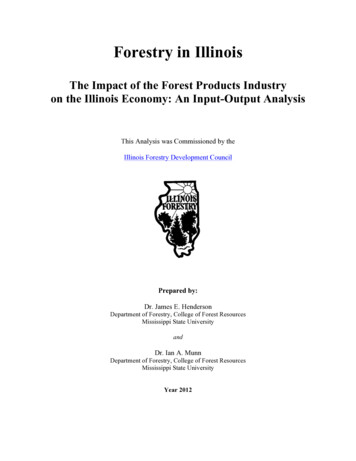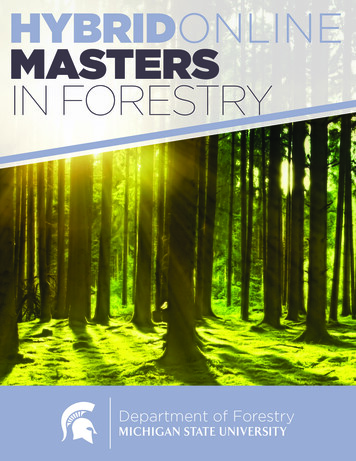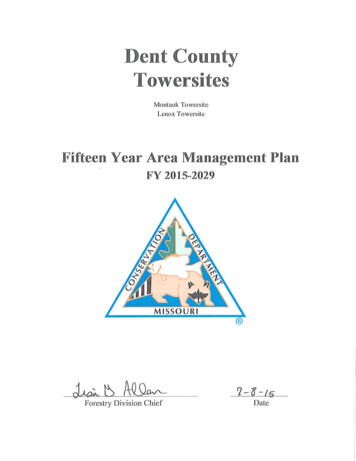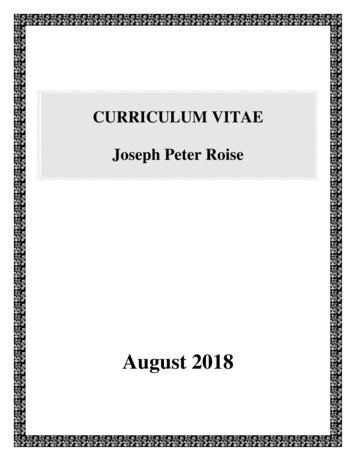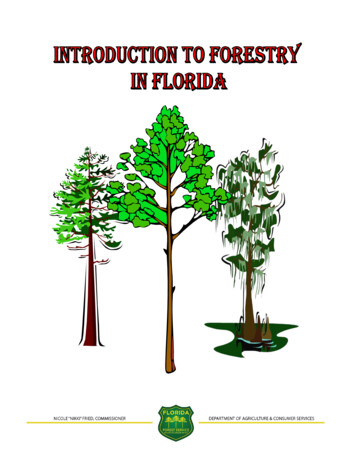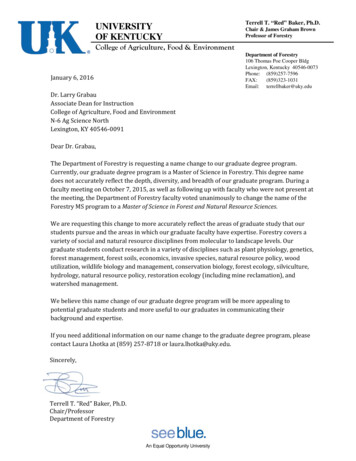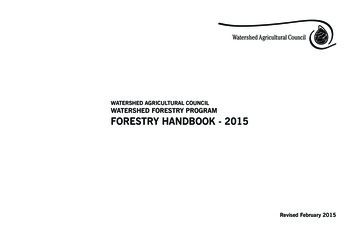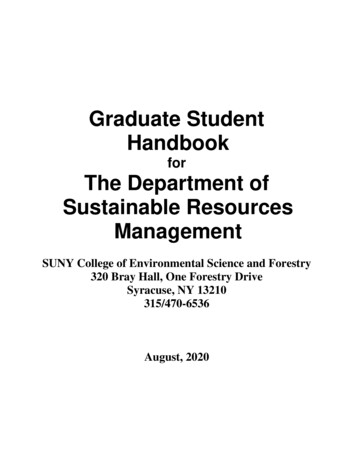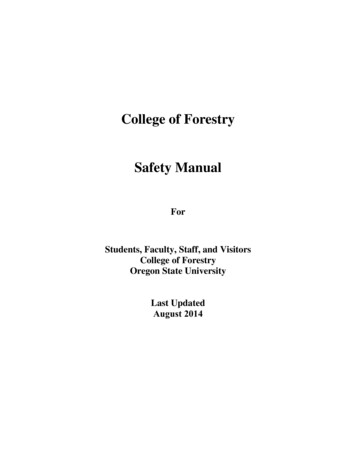
Transcription
College of ForestrySafety ManualForStudents, Faculty, Staff, and VisitorsCollege of ForestryOregon State UniversityLast UpdatedAugust 2014
College of Forestry Safety ManualTable of ContentsSection 000 – Dean’s LetterSection 100 – IntroductionSection 110 – Management Commitment to SafetySection 120 – College of Forestry Safety CommitteeSection 130 – College of Forestry Safety ProgramSection 150 – Changing the Culture about SafetySection 160 – Working Group Safety PlanSection 200 – Accident ReportingSection 300 – Laboratory SafetySection 310 – General Laboratory Safety and Chemical HygieneSection 320 – Personal Protective EquipmentSection 330 – Laboratory ChemicalsSection 340 – Safety Signs and EquipmentSection 350 – Laboratory Training and Hazard CommunicationSection 360 – Special PrecautionsSection 370 – Medical Attention and SurveillanceSection 380 – InspectionsSection 390 – Record KeepingSection 395 – Laboratory Safety ReferencesSection 400 – Forest Field SafetySection 410 – Personal Protective EquipmentSection 420 – Planning, First Aid, and Work ConditionsSection 430 – Tools, Fire Extinguishers, and ExplosivesSection 440 – Cutting Trees, Pre-commercial Thinning and SlashSection 450 – Forest DrivingSection 460 – Remote Site Safety (under construction)Section 500 – Office and General SafetySection 600 – Workshops and Shop ToolsSection 610 – Power ToolsSection 620 – Hand ToolsSection 630 – Chemical HandlingSection 700 – (Reserved for Industrial Equipment Safety)Section 800 – Koller Crew Logging Safety
College of Forestry 100: IntroductionSafety Policy & Procedure ManualSection 100: IntroductionEffective: 01 January 2007Revised: August 2014PURPOSEThe purpose of this section is to define responsibilities and expectations for safe workingprocedures in all College of Forestry activities. Within this section a) a Safety Code isestablished and defined, b) The College safety committee is established, and c) TheCollege of Forestry Safety Program is established as policy.Background InformationTo all members of the College Community;The College of Forestry is committed to providing a safe environment for our students,faculty, staff, and visitors. Safety is the business and responsibility of every campuscitizen and can be better achieved through proper education, training, use of protectiveequipment, and enforcement of safety rules. The responsibility begins at the workinglevel and extends upward through Supervisors, Managers, Directors, DepartmentHeads/Service Group Leaders, and Deans to the highest level of administration. It isessential that each of you takes an active part in initiating preventative measures tocontrol and eliminate hazards associated with activities under your direction.The Forestry Executive Committee asks that each member of the College accepts thechallenge of maintaining an accident-free and safe environment. It is your positive safetyattitude, your knowledge of safe practices, and your actions that will determine thesuccess of our safety program.Implementing a systematic approach to workplace safety will require a cultural change inmany units, among colleagues, and within the profession. All departments in the Collegeneed to nurture a "safety culture." College policy and individual work practice mustdictate that safety never take a back seat to other interests. No one should be asked – andno one should tolerate – a potentially disabling or life-threatening risk in the name ofcost-cutting, productivity or any other priority. Safety considerations must be an integralpart of the operating policies of every department.100-1
College of Forestry 110: Management Commitment to SafetySafety Policy & Procedure ManualSection 100: IntroductionEffective: 01 January 2007Revised: August 2014PURPOSEThe purpose of this section is to define the College of Forestry Safety Code and to assignthe responsibilities for the implementation of the Safety Code. In addition, the academicdepartment and service group are defined.ApplicabilityAll academic and research personnel, students, staff, and visitors in the College ofForestryPOLICYCollege faculty, staff, students, and visitors who perform any job-related activities in theCollege of Forestry are required to perform their work activities in compliance with theCollege Safety Code.ProcedureDefinitionsAn Academic Department in the College of Forestry is defined as one of the four majordepartments: Forest Engineering, Forest Resources, Forest Science, or Wood Science andEngineering. It includes all administrative staff, students, employees, and faculty110-1
(including adjunct, emeritus, courtesy, etc.) who report directly or through theirsupervisor to the Academic Department Head.A Service Group in the College of Forestry is defined as a collection of those groups orindividuals who provide a primary support role to the Academic Departments. Thisincludes the Dean’s Office, College Computing Facilities, College Business Office,College Projects and Maintenance, College Forests, College Student Services, ForestryMedia Center, College Communications, and others. It includes all administrative staff,students, employees, and faculty (including adjunct, emeritus, courtesy, etc.) who reportdirectly or through their group leader to the College Director of Operations, ExecutiveAssociate Dean, or Dean.It is the responsibility of all Academic Department heads and Service Group leaders toinstitute and communicate to all employees, students, and visitors, the College SafetyCode. The Code:1.Adds safety to the core values of the College, on the same level and with the samesupport as other values defined by the Forestry Executive Committee.2.Recognizes that the Academic Department Head or Service Group Leader is therole model for the unit, and all of his or her actions and decisions add to or detractfrom the credibility of the safety commitment.3.Ensures that the Forestry Executive Committee personally sets the standard forsafety performance.4.Establishes a comprehensive evaluation that includes a safety audit of the College,to identify existing and evolving hazards and to develop an effective system ofaccountability to ensure that hazards are controlled or abated.5.Recommends that the College annually undergoes an evaluation and discussion ofthe College’s safety performance.Each Academic Department and Service Group is responsible for adopting programs,rules and procedures that promote safety and productivity, and minimize potentialfinancial loss to the College. In addition, each Academic Department and Service Groupshall designate a department or group Safety Coordinator who shall be responsible forcoordinating the department's or group’s safety programs and representing the AcademicDepartment or Service Group on the College Safety Committee. The College SafetyCommittee shall assist all Academic Departments and Service Groups in compliance withthis order. The College Safety Committee shall:1. Adopt a written safety policy/mission statement.2. Publish and enforce safety standards appropriate to the particular needs of eachacademic department or service group.3. Establish a program to promote awareness of safe work practices.110-2
4. Institute and promote training and other educational programs for managers,supervisors, and employees to promote awareness of and competency in safework practices.5. Establish a procedure for conducting regular safety inspections/surveys so thatpotential hazards are detected, corrected and/or controlled in a timely manner.6. Promote effective investigation and management of accidental loss and workers’compensation claims.7. Maintain accurate, comprehensive records relating to injuries, accidents, propertydamage and any other incident that has or potentially will expose the state tofinancial loss. In addition, these records will be kept for a timely period to help inunderstanding the underlying conditions of accidents and injuries and lead topossible for prevention strategies.110-3
College of Forestry 120: College of Forestry Safety CommitteeSafety Policy & Procedure ManualSection 100: IntroductionEffective: 01 January 2007Revised: August 2014PURPOSEThe purpose of this section is to establish and describe the functions of the College ofForestry Safety Committee.POLICYThe College of Forestry hereby establishes the College of Forestry Safety Committee.The Committee will be composed of at least one representative from each AcademicDepartment, at least one representative from the service groups, and one representativefrom the College Forests staff. The committee members will be appointed by therespective department or group leaders (i.e., Department Heads, College Director ofOperations (for service groups), College Forests Director). The Dean will designate theChair for this Committee. Terms of service will be two years with options for renewaland a rotation schedule to ensure continuity.ProcedureThe College Safety Committee shall work closely with the Environmental Health andSafety Unit of University Facilities Services and the University Safety Committee.The current safety committee is identified as:Steve Tesch, (Chair)Jim Kiser, FERM; University Safety Committee liaison; forestry field instruction and research safetyRoger Admiral, Building and Facilities; university emergency planning initiativeJohn Mikkelson, Building and Facilities; university emergency planning initiativeSteve Fitzgerald, College Forests safetyJeff Wimer, FERM, logging/field safetyCam Jones, FES, chemical lab safetyKent Davis, WSE, wood lab safetySean SanRomani, Computing Resources, general office and employee safety120-1Kori Ault, FES, biohazards safety
College of Forestry 130: College of Forestry Safety ProgramSafety Policy & Procedure ManualSection 100: IntroductionEffective: 01 January 2007Revised: August 2014PURPOSEThe purpose of this section is to establish and describe the College of Forestry SafetyProgram.POLICYIt is the policy of the College of Forestry to provide a safe environment for ALL OFITS EMPLOYEES, STUDENTS, AND VISITORS. In addition, it is the policy of theCollege of Forestry to fully comply with the Oregon Administrative Rules - OregonOccupational Safety and Health Division 437-007-0100.437-007-0100 Safety and Health Program. Every employer must implement a written safetyand health program that establishes management commitment, supervisory responsibilities,accident investigation, employee involvement, hazard identification, training, and annualevaluation of the program.Stat. Auth.: ORS 654.025(2) and 656.726(4).Stats. Implemented: ORS 654.001 through 654.295.Hist: OR-OSHA Admin. Order 5-2003, f. 6/02/03, ef. 12/01/03.ProcedureIt is the purpose of this policy to:1. Abide by all University, federal, state and local regulations as they pertain to ourmission.130-1
2. Apply good sense and safe practices to all jobs.3. Exercise good judgment in the application of this policy.To further these goals the following assignments of responsibility are made;Management1. Establish rules and programs designed to promote safety and make known to allemployees the established rules and programs.2. Provide all supervisors with copies of appropriate rules and regulations.3. Make available training necessary for employees to perform their tasks safely.4. Provide protective equipment for employees where required.5. Impress upon all the responsibility and accountability of each individual tomaintain a safe workplace.6. Record all instances of violations and investigate all accidents.7. Provide disciplinary action for any employee(s) disregarding this policy.8. Appoint a College employee with enforcement authority over safety matters.9. Insure that safety inspections are conducted of all the College’s worksites,maintain records, and continually monitor the safety program for effectiveness.Supervisors1. Be completely responsible for on-the-job safety and secure the correction ofsafety deficiencies.2. Make sure proper safety materials and protective devices are available and usedand all equipment is in safe working order.3. Instruct employees in safety requirements.4. Review accidents, supervise correction of unsafe practices, and file accidentreports.5. Conduct jobsite safety meetings and provide employees with proper instruction onsafety requirements.6. Notify Department Heads and Group Leaders of safety violations.Crew Leaders1. Carry out safety programs at the work level.130-2
2. Be aware of all safety requirements and safe working practices.3. Plan all work activities to comply with safe working practices.4. Instruct new employees and existing employees performing new tasks on safeworking practices.5. Make sure protective equipment is available and used.6. Make sure work is performed in a safe manner and no unsafe conditions orequipment is present.7. Correct all hazards, including unsafe acts and conditions which are within thescope of your position.8. Secure prompt medical attention for any injured employees.9. Report all injuries and safety violations.Crew members1. Work safely in such a manner as to ensure your own safety as well as that ofcoworkers and others.2. Request help when unsure about how to perform any task safely.3. Correct unsafe acts or conditions within the scope of the immediate work.4. Report any uncorrected unsafe acts or conditions to the appropriate supervisor.5. Report for work in good mental and physical condition to safely carry outassigned duties.6. Avail yourself of College sponsored safety programs.7. Use and maintain all safety devices provided.8. Maintain and properly use all tools under your control.9. Follow all safety rules.10. Provide fellow employees help with safety requirements.All Personnel1. Strive to make all operations safe.2. Maintain mental and physical health conducive to working safely.3. Keep all work areas clean and free of debris.130-3
4. Assess results of your actions on the entire workplace. Work will not beperformed in ways that cause hazards for others.5. Before leaving work replace or repair safety precaution signs removed or altered.Unsafe conditions will not be left to imperil others.6. Abide by the safety rules and regulations of every work area.7. Work in strict conformance with federal, state and local regulations.Disciplinary policyThe College expects that all persons will adhere to safety procedures and policies in ourdaily work activities. Non-compliance activities shall be brought to the attention of theimmediate supervisor and a written action shall be documented that includes remedialefforts of the non-compliance activity.130-4
College of Forestry 150: Changing the Culture about SafetySafety Policy & Procedure ManualSection 100: IntroductionEffective: 01 January 2007Revised: August 2014PURPOSEThe purpose of this section is to introduce the concept of culture change and awareness ofsafety in the workplace.Background InformationThere is a wealth of information available on safety in the workplace and safety programswithin the workplace but there are several common themes. First and foremost is that thestrength of any company or organization is its people. The second is that the key tosuccess depends on a visible management commitment to safety. The third iscommunication and reporting. Fourth is the belief that all injuries and fatalities arepreventable and that” unsafe is unacceptable.” Finally, it is important that everyoneunderstand that safety begins at home and in our daily lives. The idea is that safety inthe workplace is a continuation of safety in our daily practices.Creating a Culture of SafetyThe key according to industry and agency experts is to maintain effective standards toprotect worker health and safety. Standards are voluntary practice guidelines to helpworkplaces meet regulatory requirements. It has been proposed that workplaces may electto follow either prescriptive, process-driven standards or performance-based standards.Prescriptive, process-driven standards provide rules defining specific actions that must betaken in various situations. Performance-based standards are designed to meetperformance goals without specifying how they are to be achieved. A small number ofcompanies favor performance-based standards, while the majority prefer prescriptivestandards. Scare programs, reminders, incentives and other magic bullets don’t work.They might change reporting but they don’t change behavior. The most effectivemotivations for safety are peer safety culture, management credibility, and anorganizational safety system.150-1
Employer and Supervisor Actions for Healthier and Safer Workplaces1. Taking responsibility - Ensure that you have an effective worker/employeroccupational safety committee to help identify and reduce workplace hazards (for higherrisk workplaces).2. Meeting standards – Develop and constantly review the health and safety standardsthat apply to your work and ensure that these standards are fully met.3. Getting help – Have contact with a safety association, private consultant or theOccupational Safety & Health Administration (OSHA) for more information onensuring your working conditions are as good as they can be.4. Training workers - ensure that all workers are properly trained and supervised bycompetent personnel to work safely. Young and/or new workers tend to have moreworkplace injuries, largely due to inadequate training and supervision.5. Changing workplace culture - demonstrate a genuine commitment to workplacehealth and safety at all levels of the organization, starting at the top. Make health andsafety an integral part of organizational meetings, hiring, promoting, objectives,publications and reviews.Employee Actions for Healthier and Safer WorkplacesEveryone has responsibility for workplace health and safety. When it comes to workplacehealth and safety, workers have the most to gain . or lose. The action steps below helpworkers exercise their fundamental rights and responsibilities to know, to participate,and to refuse unusually dangerous work.1. Getting involved – Employees should be encouraged to assist the College SafetyCommittee identify and reduce workplace hazards.2. Meeting standards - know the health and safety legislated standards that apply to yourwork and your workplace. Cooperate with your employer and fellow workers in meetinghealth and safety standards. Support initiatives to exceed these standards where possible.3. Getting help - contact the College Safety committee, health and safety web sites, OSHA,or other reliable sources for more information on working conditions. Be mindful ofnot only shorter-term safety issues, but also longer-term health issues related to thework you do.4. Being trained - get the proper training for any job you do so that you can do the taskswithout endangering your safety or health - or the health and safety of your fellowworkers.150-2
5. Walking the talk - demonstrate a genuine commitment to health and safety - on andoff the job. Make health and safety an integral part of your way of life . and supportothers in protecting their health and safety.150-3
College of Forestry 160: Working Group Safety PlanSafety Policy & Procedure ManualSection 100: IntroductionEffective: 01 January 2007Revised: August 2014PURPOSEThe purpose of this section is to define the Working Group, introduce the Working GroupSafety Plan and provide information for creating a safety plan applicable to individualworking groups.Background InformationA written Safety Plan is required for each working group and responsibility for the safetyplan falls under the working group leader, supervisor, or a designated safety officer.PolicyIt is the policy of the College of Forestry that each and every working group will have awritten safety plan and that all workers in the working group shall read and acknowledgethat the safety plan has been reviewed with them by their supervisor or designated safetyofficer.160-1
ProcedureA Working Group in the College of Forestry is defined as any subset of individuals in anAcademic Department or Service Group who have specific jobs, expertise, and goals.These groups report to an individual working group leader who then reports to theAcademic Department Head or Service Group Leader. Examples of working groupleaders include Principle Investigators (P.I.’s), and persons designated to head specificservice groups (i.e., head of student services or facilities services).The working group safety plan is a document that contains the following nine sections:1.2.3.4.5.6.7.8.9.Safety PlanJob Safety Analysis (JSA)JSA FormsAcknowledgement FormsCompleted AcknowledgementsAccident ReportingAccident Reporting FormsSAIF 801 FormsCompleted Accident FormsAll working group safety plans will follow the same format. This is necessary forconsistency within the College and for ease of identification by outside auditors (i.e., FireDepartment Inspection personnel). The College Safety Committee has developed aprocedure for creating uniform plans and is willing to assist any working group in thedevelopment of their individual plan.Instructions for creating the plan follow. All files referenced are located on the CDenclosed with the example safety Plan available from the Safety Committee.Directions for Building the Working Group Safety Plan ManualStep 1You will need 2 sets of Avery 5-Tab Dividers and a 1 ½ or 2 inch white binder.Step 2Copy the file Safety Plan Heading Inserts and print this out on to the includedinserts page. Slip the inserts in this order:1.2.3.4.Safety PlanJob Safety AnalysisJSA FormsAcknowledgement Forms160-2
5. Completed Acknowledgements6. Accident Reporting7. Accident Reporting Forms8. SAIF 801 Forms9. Completed Accident Forms10. This divider is not usedStep 3Copy the file Example Non-chemical Lab Safety Plan or Example ChemicalLab Safety Plan depending on the type lab or work group. This document mustbe customized for each lab or work group. Please see a Safety Committeemember for help with this if needed. If you have a chemical lab, you will alsoneed to copy the file Example Chemical Hygiene Plan and customize this filefor your lab or working group.Step 4Copy the files for the appropriate floor maps for either Peavy Hall orRichardson Hall. These will need to be customized for the specific evacuationroutes for your lab or working group.Step 5A copy of the front page of the Safety Plan goes in the clear sleeve on the frontcover of the binder. A side insert that says Safety Plan in large font goes in thespine.Step 6The Evacuation plan goes in the front sleeve of the folder.Step 7A copy of the revised Safety Plan goes in the first section.Step 8Copy the Acknowledgement of Safety Rules page and highlight those sectionsappropriate to your lab. Copy the Job Hazard Analysis page and highlight theappropriate job hazards. Finally copy the Job Safety Analysis manual sectionand put all of these in section 2. The appropriate job hazards for your lab shouldbe highlighted to match those listed on the Job Hazard Analysis page.Step 9Make additional copies of the Job Hazard Analysis page and store in section 3.Step 10Make additional copies of the Acknowledgement of Safety Rules page and storein section 4.160-3
Step 11Store completed Acknowledgement forms in section 5.Step 12Copy the Accident Reporting section and put this in section 6.Step 13Make 10 or more copies of the Accident Reporting form and put these in section7.Step 14Make 10 or more copies of the SAIF 801 forms and put these in section 8.Step 15Store completed accident forms in section 9.Step 16Once completed, please register your safety plan manual with the safetycommittee to make sure you receive updates.The Lab or Working Group Safety Plan will be stored in a readily accessible location foreasy access and reference. An electronic copy is to be archived.160-4
College of Forestry 200: Accident ReportingSafety Policy & Procedure ManualSection 200: Accident ReportingEffective: 01 January 2007Revised: August 2014PURPOSEThe purpose of this section is to make standardized information available for the processof reporting accidents. Included in this section are links to the required forms necessaryin the event of a work-related accident and a flowchart that details the process forreporting accidents.Background InformationMost accidents are caused by the failure of people, equipment, materials, or environmentsto behave or react as expected. Accident investigations are an important part of theCollege of Forestry's and University’s safety programs through accident prevention.An important aspect of the entire accident prevention effort is the College's andUniversity's ability to record and track the complete accident experience. This includesnot only accidents to employees, but also to students, visitors, and volunteers. TheReport of Accident form has been developed to provide the accident-related informationin a uniform manner. The information originates at the department level and is then sentto College and University committees and departments that oversee loss control andemployee benefit programs, such as the College Safety Committee, the Office of HumanResources (OHR) and Environmental Health and Safety (EH&S). These groups can thendirect their efforts and resources to the areas of greatest concern. The College of Forestryaccident reporting is intended to conform to the University and OR-OSHA requirementsfor reporting of all accidents.200-1
ApplicabilityAll academic, research, students, and visitors in the College of Forestry.ProcedureAll accidents that occur on the job and result in injury must be investigated and reportedin a timely manner. Late reports result in unnecessary fines and delayed or deniedclaims. Incidents (accidents involving no medical claims or time lost) must be reportedon a Report of Accident form. Accidents involving medical claims or time lost must bereported on the SAIF 801 form (State of Oregon Worker’s and Employer’s Report ofOccupational Injury and Disease) and the Report of Accident form.These forms must be delivered to OSU Human Resources within 48 hours of theaccident or incident.SUPERVISOR RESPONSIBILITY IN ACCIDENT REPORTINGSupervisors are responsible for completing and filing the necessary report forms andperforming an accident investigation of all injury-related accidents. Accidentinvestigations are to be conducted with prevention in mind and should not be done toplace blame.Accidents involving Employees or VolunteersFor injuries or accidents occurring to employees or volunteers, the supervisor mustdiscuss the incident with the employee or volunteer and any witnesses before completingthe reports. The supervisor must also make any necessary changes in procedures orconditions to prevent similar accidents.200-2
Accidents Involving Students or VisitorsAll injuries incurred by students and visitors at the University should be investigated andreported. The responsibility for reporting has been assigned to the instructor ordepartment administrator who was in charge of the area, class, or function during whichthe student or visitor was injured. The injury is reported on a Report of Accident formand it is important to include all pertinent information about the accident and the namesof any witnesses.Accident Reporting ProcedureREPORT OF ACCIDENT FORMThe Report of Accident form must be completed by the supervisor as soon as possibleafter the accident. Forms are available from the department office or OHR. The form'spurpose is to gather facts on how the accident happened, names of witnesses, and whatmedical treatment was required. A copy of the completed Report of Accident form mustbe sent to Human Resources Staff Benefits. If an accident involving an employeeeventually requires medical treatment or involves time lost, the original Report ofAccident form is sent to OHR along with the SAIF 801 form.In the event that it is not possible to get the form to OHR within 48 hours, the reportcan be faxed to 541-737-7771.The Office of Human Resources is responsible for sending a copy of the Report ofAccident and SAIF 801 forms to EH&S who may decide to investigate the accidentfurther. Supervisors should assist EH&S in this investigation because of the lag timeassociated with the written reports. All serious accidents should also be reported bytelephone to EH&S as soon as possible (541-737-2273).SAIF 801 FORMThe SAIF 801 Form must be completed in addition to the Report of Accident form for allon-the-job injuries that cause lost work time and/or require off-campus medical attention.This form is used to claim payment of benefits for an occupational injury or illness.Forms are available from OHR and completed forms must be filed with OHR within 48hours of the accident. Questions regarding Workers' Compensation claims, Report ofAccident forms, or SAIF 801 forms may be addressed to the Office of Human Resources,at 737-2916.Delivery of Report FormsIt is the responsibility of the supervisor to deliver original copies of the forms to theCollege of Forestry Office of Human Resources. Copies of the accident report forms areto be delivered to OHR and the department office manager.200-3
FATALITY OR OTHER SERIOUS ACCIDENTAny on-the-job accident that results in a fatality or the immediate hospitalization of anemployee shall be reported WITHIN 8 HOURS by telephone to Environmental Healthand Safety (541-737-2273), who in turn will make the required notification to OregonOccupational Safety & Health Agency (OROSHA).200-4
Accident Reporting ProcessNon fatalaccident notrequiringimmediatehospitalizationand does notrequiremedicalattention orresult in losttime.Supervisor fills outAccident ReportsReport of Accident formImmediatelySubmit forms toCollege of Forestry HR737-2448COFHRWithin 48 hoursSubmit forms toOSU HRPhone 737 – 2916FAX 737 - 7771ImmediatelyAccident thatrequiresmedicalattention orresults in losttime.Fatality oraccident thatrequ
compensation claims. 7. Maintain accurate, comprehensive records relating to injuries, accidents, property . FES, biohazards safety 120-1 . College of Forestry 130: College of Forestry Safety Program. . Plan all work activities to comply with safe working practices. 4. Instruct new employees and existing employees performing new tasks on safe
